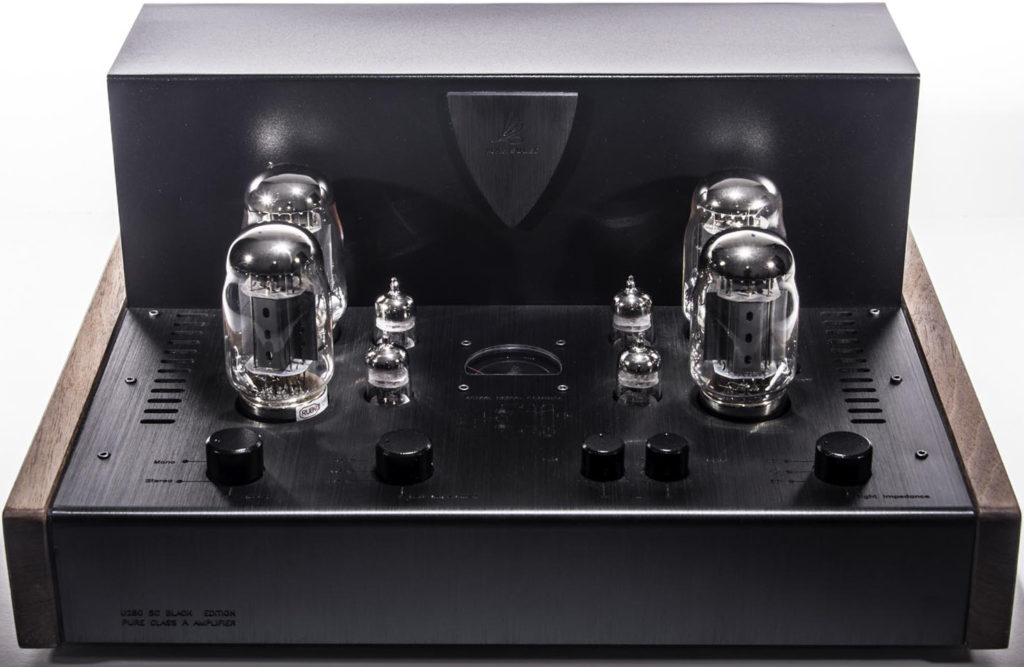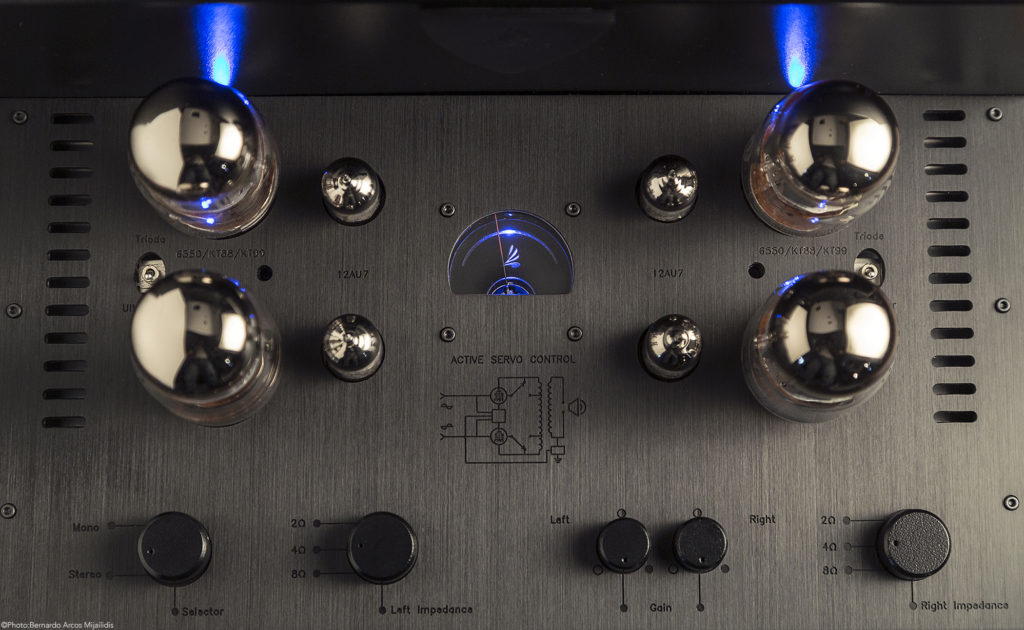Design History
This is the fourth product I have reviewed from Margules. The quality and value of these products make me continue to question why they are not better known in the overall audiophile world. Julian Margules of Margules Group has been an audio manufacturer for over 40 years and is well known in Mexico and other parts of the world. Still, I had never heard of them until 2010 and never heard one of their products until one of the early California Audio Shows. Margules Group is located, and their products are manufactured, in Mexico City.
The U280-sc amp has been a staple of the Margules line for years. Two years ago I reviewed the 25th Anniversary Edition of this amp. It is a Class A tube amplifier that can operate in either ultra-linear or triode mode. The U280-sc is a Class A push-pull design that delivers 50 watts per channel into 8 ohms. If you use it in triode mode, it delivers 25 watts into 8 ohms.
The amp uses a Class-A output stage with what they refer to as “Active-Servo Bias.” Class-A operation causes the tubes to run quite hot and increases the chance of saturating the output transformer. Margules says they have resolved this problem by incorporating a redesigned 12th generation Active Servo Bias, with a faster and more precise bias setting. The active servo bias actively tracks the input and output signal, allowing a full class-A output at any level or mode, without overdriving the tubes and transformers. Active Servo Bias also sets DC bias and AC drive levels, assuring optimum electrical and sonic performance throughout the lifespan of the output tubes, no drive or bias adjustments are ever needed. New tubes can be installed without test equipment. The Active Servo Bias also makes it possible to use a variety of output tubes. The 6550, KT88, KT99, KT100, KT 120 can be interchanged without modification.
The Active Servo Bias is implemented with semiconductors, which are designed for the aerospace industry, assuring long, trouble-free operation. The amp is switchable between triode and ultra-linear operation. It also allows the outputs to be strapped, for twice the output; so you can use two as mono-block amps. This would allow you to use the triode operation at the same power level as the ultra linear on a single amp. There are separate gain controls for each channel, which make precision balancing easy to simplify further the setup of bi-amped systems. The U280-sc uses no negative feedback, which is a plus in my way of thinking.
The build quality of the new “Black” version is even more beautiful. The aesthetics of the design is complemented with a new epoxy pc boards, military grade potentiometers, precision metal-film resistors, and audio grade interstage capacitors. The wood now used for side panels is oil rubbed, tropical hardwood. It also has a new fascia, new knobs, and transformer box materials. I think everything about it looks like it should cost at least twice its asking price.
I asked what improvements the Black had over the Anniversary version of the U280 I reviewed two years ago. According to Carlos Smith, there is new cabling and PC design and configuration for even better signal transmission. There were upgrades in certain electronic components, to a lower noise floor, improved clarity and response across the frequency spectrum.
They also redesigned their “Active Servo Control” circuit, which has always been one of the hallmarks of Margules´ amplifiers. They redesigned the differential circuit to decreased distortion and improved the power supply for lower power consumption, increased thermal efficiency, and lower operating temperature. In an effort to further lower the noise floor they have improved the grounding of the amp.
Listening with the Margules U280-sc “Black” Amplifier
When reviewing the 25th Anniversary Edition of this amp, I said, “Well, I can say one thing for sure, my system surely sang with the Margules U280-SC in my reference system. It didn’t matter if it was in ultra-linear or triode mode. Let’s start by talking about how it sounded in ultra-linear mode. In this mode, the U280-SC exhibited big tuneful bass with real impact. There was nothing about the bass of this amp that screamed tube or transistor. In fact, the bass sounded like some of best solid state amplifiers with a tight, controlled bottom-end.
In ultra-linear, the midrange was clear, transparent yet it still had beautiful tonal colors. Midrange notes did not stand out because the presentation was overly warm or romantic but stood out because of how well it was integrated within the musical spectrum. There was nothing over emphasized or over exemplified. There was no hint of roll off in the top-end. Cymbals, for example, had very nice shimmer without any hint of splatter.” All of this is still true about the “Black.” As I listened to the “Black” in ultra-linear mode, I thought that it did many of the things that the Pass Labs XA30.8 accomplished, like the way it controls the bass and the air in the top-end.
Next, let’s talk about how it sounds in triode mode; just as I expected the background became quieter, and the music came even more to life, and the midrange had more pop. The sound had even more beautiful tonal colors. The biggest difference is that in triode mode there is more of what makes good tube amps special. There was great soundstaging, dimensionality, and imaging; all with the sense of space and midrange richness that you rarely get from anything but a great tube amp.
It is incredible that a triode tube amp could have this kind of bass. The bass was fast enough to provide pace, rhythm, and timing. I especially like the natural bloom the bass has in triode mode. One of the things that I really liked about this amp was how a standup bass, a bass drum, and the bass end of a piano could all have their space, and each has different dynamics all at the same time much like live music.
The amp does a superb job on all kinds of instruments of bringing exciting dynamics and energy to the music. This “Black” isn’t about being the most exacting amp; it’s about the harmonics, how the decay sounds, how the music blooms, and how much like real music it sounds.
Conclusion
As much as I like the “Black” in triode mode one of the amp’s strengths is how good it sounded in the ultra-linear mode. This gives one the opportunity to own a Class A amp that can drive rather inefficient speakers. I should also mention this amp brought out the best of a very good digital source. Some might say that means it is a forgiving amp, but I’d rather say that somehow it lets you hear the best of the source as long as it is a good musical source.
I did not have the “25th Anniversary” and the “Black” at the same time, and after two years I can’t tell you where they sound different. What I can tell is that the “Black” is a wonderful Class A tube amp. Still, like its predecessor in the ultra-linear mode, it neither shouts tube or transistor. It does sound like a good Class A amp. In triode mode, it shares most of what I think of the very best of Class A, No Feedback amps and little of tube amp shortcomings. I would have to agree with the statement on their website; the “Black” delivers a “Tangible Musical Experience.” Highly recommended!
- (Page 1 of 1)



I have the 20th Anniversary version of this amp. Before that I had an Audio Research D-70 amp. I only replace a component if I find something significantly better or if frequent repairs becomes an issue. When repairs became a problem with the D-70, I started to search for a new amp. Once I heard the Margules system at a CAS, my search ended. My two main speakers are the Fulton J and the Dunlavy SC-IV. The Dunlavy’s are rated at 91 dB and the Fulton’s at something like 87 dB. The Margules amp was a clear improvement over the D-70, especially in the bass and in presenting a clear, but effortless sound. Even in ultra-linear mode, the sound was much clearer, with improved tonality. In triod mode, the sound has even better tonality and liquid, effortless sound. I listen mostly (about80 percent of the time) in triod mode. Only when the music becomes extremely demanding, do I change. I also love the Rosewood trim of the amp which matches the Rosewood of my VPI Classic Two. I have no desire to change anything in my current system (Fulton Js or Dunlavys, VPI Classic Two, Lyra Delos cartridge, Counterpoint SA-2 pre-pre amp, Audio Reasearch SP 8 preamp).
Dear John,
Thank you so much for your kind words regarding our Margules U280 amplifier. We are so happy to hear from satisfied music lovers -especially if they enjoy it on our equipment!
Unfortunately we cannot leave well enough alone, so please stop by CAS this weekend to hear how our components have evolved, and allow us to upgrade your amplifier to over 80% of the newest technological and performance benefits. Please do send an e-mail to see how we may be of service to you. Margules…for the love of music.